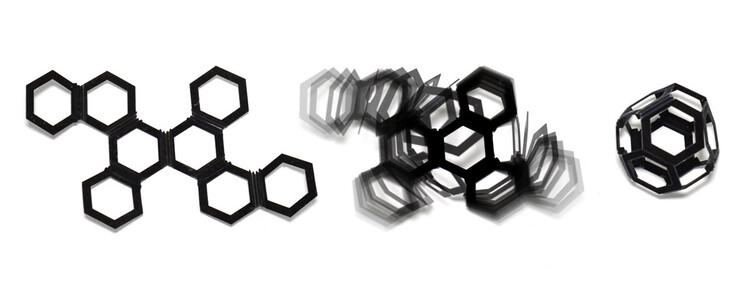
While we are still trying to understand the possibilities and limits of three-dimensional printing and additive manufacturing, a new term has emerged for our vocabulary. 4D printing is nothing more than a digital manufacturing technology -3D printing- which includes a new dimension: the temporal. This means that the printed material, once ready, will be able to modify, transform or move autonomously due to its intrinsic properties that respond to environmental stimuli.
The concept was popularized by researcher Skylar Tibbits, who coordinates the Massachusetts Institute of Technology (MIT) Self-Assembly Lab, in collaboration with Stratasys and Autodesk. The technology is still quite new, but it is expected to be used in many fields, from construction, infrastructure, automobile and aeronautics and even for healthcare, combined with bioprinting.

4D printing directly dependent on the materials used to create the object. So-called intelligent materials, as researcher Anna Ploszajski shows in this lecture, are solids that have a property - their shape, dimensions or color - that changes in response to an external stimulus, such as heat, light, humidity, pressure or magnetism, simple due to its internal material properties. According to Anna: “Today’s three-dimensional material world is made from passive, inanimate materials like brick, steel and glass. Four-dimensional structures are made from active, animated, so-called ‘smart materials’ which move autonomously – swelling, shrinking or bending in reaction to a stimulus – combined with passive materials. That allows them to move and change shape without robotics, electronics or engines.”

She cites the example of the pine cone as a natural intelligent material. The way it functions is through two layers of rigid fibers that run in different directions, allowing the opening or closing of the cone, so that the seeds are only released when the time is favorable for germination in the soil (hot and dry). When humidity is high, the cone remains closed, protecting the seeds. This is one example of how seeking to understand and replicate nature's complex processes of adaptability, resilience and efficiency is something that motivates materials engineers. It is also the driving force behind biomimicry, in which 4D printing can materialize many of the ideas that technology has not yet achieved.


The main purpose of 4D printing is to be able to program the material, making it react according to environmental parameters. But what can this be used for? In this talk, Skylar Tibbits shows some ongoing experiments in which objects, when heated or stimulated in some way, bend and assume other three-dimensional volumes. The researcher also mentions the various other possibilities for 4D printing, such as in the field of infrastructure: for example, a drainage pipe that can contract or expand with the flow of water; or a sewer system that can transport waste through contractions and relaxations similar to the peristaltic movements of the intestine, which can overcome slopes in the terrain.

.jpg?1628794810)
Future applications may be seen within the construction and manufacturing or advanced materials industries where parts can self-transform from raw materials to final built-in-place structures without human intervention. This is truly a radical shift in our understanding of structures, which have up to this point, remained static and rigid (aero-space, automotive, building industries, etc.) and will soon be dynamic, adaptable and tunable for on-demand performance. 4D Printing enhanced by multi-materials technology may likely revolutionize our ability to control and precisely program materials from idea-conception to printing shape-changing transformations. (Skylar Tibbits | The Self-Assembly Lab, MIT)
There are also already serious research on 4D printing of polymeric materials for tissue and organ regeneration, or even for bone reconstruction. The possibilities are endless and experimentation can go much further. Imagine everything that intelligent materials and 4D printing could provide to building envelopes, adapting to the climate and responding to the most diverse stimuli. Even though the technology is still in its infancy and is concentrated in a few tech labs around the world, it looks like it has a promising future. When we seek to understand and imitate nature rather than master it, the results are often impressive. If history shows that it's not the strongest that survives, but the one that adapts best to change, 4D printing with smart materials seems like something to consider.
Note: This article was originally published on August 29, 2021.
This article is part of the ArchDaily Topic: New Practices, proudly presented by PERI. PERI’s Future Products and Technologies’ department researches disruptive technologies that have the potential to change the construction industry fundamentally. The aim is to recognize the signs of the future and to help shape this future. Through a methodical approach, PERI thus expands its core competencies and acts as a clear pioneer on the market. Learn more about our monthly topics. As always, at ArchDaily we welcome the contributions of our readers; if you want to submit an article or project, contact us.









.jpg?1628794810)